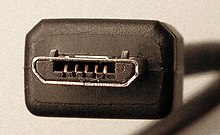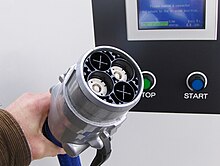Charging plug
Charging plug and charging socket are a subgroup of connectors for connecting mobile devices in order to charge their batteries electrically. In many cases, signal contacts are also connected in addition to the contacts for charging current.
Cellphone
In the area of devices with limited space (e.g. digital cameras, cell phones, MP3 players and other mobile devices), manufacturer-specific plug contacts have largely been replaced by connections based on USB ( Universal Serial Bus ). The USB 2.0 standard requires a supplied voltage between 4.4 and 5.25 volts. The permitted power requirement of the end devices was specified in USB 2.0 with 5 levels of 100 mA each; at maximum current demand, up to 0.5 amps are possible for one end device. For the specification of USB 3.0 this was extended to 6 levels of 150 mA each; the maximum current demand is then 0.9 amps.
There is also an extension of the “Battery Charging Specification”. For USB-A-2.0 charging plugs, the charging current was set to typically 1500 mA, which can be used up to full-speed USB signals (at high-speed a maximum of 900 mA). For dedicated charging plugs in USB connector format without USB signaling, up to 1.8 amps at 5.25 volts can be provided.
The standardization of charging plugs in USB connector format was promoted by the decision of China. Since June 14, 2007, it has been required that all cell phones with USB plugs can use them to charge the devices. In September 2007, the members of the Open Mobile Terminal Platform (including Nokia, Samsung, Motorola, Sony Ericsson, LG) agreed on micro-USB as a uniform standard for future connectors.
On February 17, 2009, the finished standard was presented at the GSMA Mobile World Congress in Barcelona and it was stated that 17 manufacturers of mobile radio devices had agreed to only offer these micro-USB-based connectors from 2012 onwards. The presented specification not only extends the USB signaling (OMTP protocol), but also provides a charging specification known as the "Universal Charging Solution". The UCS charging standard was then adopted by the CTIA and ITU without any changes . In June 2009 the EU Commission reached an agreement with 10 manufacturers (Apple, LG, Motorola, NEC, Nokia, Qualcomm, Research In Motion, Samsung, Sony Ericsson, Texas Instruments) that from 2010 onwards only mobile phones will be available on the European market that are compatible with UCS charging plugs. A maximum charging current of 850 mA at 4.75 to 5.25 volts is specified in the UCS.
There are also more and more public charging plugs, for example at airports or on long-distance trains. Please note the following:
- Incorrect voltage : The device can be damaged due to incorrect voltage or a defective plug.
- Data transfer : A manipulated USB connector can transfer malware because data is transferred via the connection (smartphone).
Electric vehicles
Public charging stations
The type 2 connector is standardized for European electric vehicles . The charging station ordinance issued in 2016 stipulates that newly built, publicly accessible charging stations that provide alternating current must be equipped with a plug or a coupling according to IEC type 2 . If they provide direct current, a connection with a Combo-2 coupling must be installed.
Commonly used plugs, also as charging plugs for electric vehicles

single-phase, 230V: Schuko socket (blue, small)
caravan plug (blue 16 A)
three-phase, 400V: three-phase socket (red 32 A)
In relation to single-phase alternating current with 230/240 volts, all vehicles can currently (beginning of 2016) be charged from existing sockets (in some cases via adapter or ICCB cable) , provided that they can supply a constant 10 A. The disadvantage here is the charging power, which is limited to 2.3 kW.
Before the introduction of the type 2 system, charging stations based on the CEE system had been built in Europe . In addition to household sockets, mainly connectors according to IEC 60309 were used, which have established themselves in outdoor areas due to their robustness. Plugs for 400-volt three-phase current and charging currents from 16 A to 63 A ( 3L + N + PE, 6h - red 5-pin site power plug ) offer high charging capacities, while the blue 3-pin plug for 230 V alternating current has single-phase charging current 16 A ( L + N + PE, 6h - camping or caravan plug ) is used.
Due to the use of such plugs in trade and industry as well as in camping vehicles and boats, numerous charging points for electric vehicles have been created. Some non-commercial activities to set up a comprehensive charging infrastructure also used these plug-in systems.
Special charging plugs for electric vehicles
For the field of electric cars , a uniform connector standard was pushed for even before their widespread market launch. However, several proposals have spread.
The advantages are standardized plugs for different charging capacities and, in some cases, better handling. The disadvantage is the lower distribution and the higher costs for private and non-commercial users.

In Germany and France, the car manufacturers have agreed on a proposal from the connector system manufacturer Mennekes , which was created from the company's existing IEC 60309 connector variants in which additional signal pins were added to the three-phase connectors (also known as "CEEplus"). This charging plug was standardized in VDE-AR-E 2623-2-2 and submitted for the next version of the international standard IEC 62196 . It is a 7-pin round plug the size of the previous 16 A plug (56 mm diameter), which allows connection to the 400-volt three-phase network that is widespread in Europe (specified up to 63 amperes charging current). It can also be charged with 230 V single-phase alternating current. The distinction between the maximum charging current and the voltage supply is signaled via the two additional contacts. The power coding is initially carried out in accordance with IEC 62196-1 using resistor bridges. An RFID chip is provided for authorization at public charging stations and can also be inserted into the connector housing. The Mennekes proposal or VDE standard plug for charging stations is also known as IEC 62196-2-X, based on the subsequent standard currently being developed.
In North America, the standard SAE J1772 known from 2001 has been revised (it was originally a square connector for floor and lift trucks). The North American automakers agreed on the Yazaki proposal. It is a 5-pin round plug with a diameter of 43 mm, which is intended for connection to single-phase alternating current. The specification contains specifications for connection to the 120-volt household electricity common in North America (level 1 specified charging current up to 16 amps at a maximum of 120 volts) as well as the 230-volt household current common in Europe (level 2 specified charging current up to 80 amps) at a maximum of 230 volts).
In addition, there is the standard created in Japan (JARI Level 3 DC), which is already used as a CHAdeMO system in Japan, North America and increasingly in Europe and is supported by the Japanese automobile manufacturers Mitsubishi, Nissan and Subaru. It should be noted here that it is a matter of high direct currents, which are supplied directly to the drive battery by the charging station after communication with the vehicle electronics.
Common to all standards is the specification for the control protocol between the charging station and the vehicle based on the IEC 62196 standard . This provides for a current call up to 250 amps at up to 690 volts three-phase current, but also names charging cycles for single-phase and direct current networks.
Both the Yazaki proposal and the Mennekes proposal use two additional contacts - a trailing protective contact, without which the charging station is de-energized, and a leading signal contact via which a lock can also be activated. The additional contacts are bridged for connection to household sockets (corresponding to a maximum of 16 amps at 230 volts).
An original design for a type 3 connector from the so-called EV Plug Alliance could not prevail.
Individual evidence
- ↑ USB Implementers Forum, Inc. (ZIP file with two PDF documents): Archived copy ( Memento from March 4, 2016 in the Internet Archive ). Retrieved October 13, 2014.
- ↑ Public USB charging plugs. In: Doc-Phone.de. February 14, 2017, accessed December 3, 2019 .
- ↑ The Schuko system used in Germany and Austria generally only allows a continuous current load of up to 10 A (with 16 A short-term load)
- ↑ a b Tomi Engel: The network integration of electric vehicles. In: Sonnenenergie, September 2009 (PDF; 831 kB)
Web links
- List of charging plugs used in 2009 for electric cars, with photos ( Memento from February 14, 2010 in the Internet Archive )


